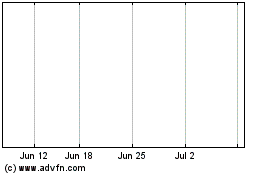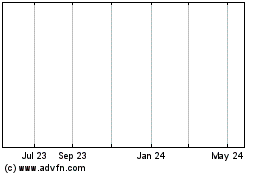A little-known New York hedge fund run by a former Yale
University math whiz has been buying tens of billions of dollars of
U.S. Treasury debt at recent auctions, drawing attention from the
Treasury Department and Wall Street.
Element Capital Management LLC, led by trader Jeffrey Talpins,
has been the largest purchaser in dozens of government-bond
auctions over the past 10 months, people familiar with the matter
said. The buying is part of an apparent effort by the fund to use
borrowed money to exploit small inefficiencies in the world's most
liquid securities market, a strategy that is delivering sizable
profits, said people close to the matter.
Mr. Talpins is an intense and reserved trader formerly at
Citigroup Inc. and Goldman Sachs Group Inc. He is known for a
tenacious style that can grate on rivals and once tested the
patience of former Federal Reserve Chairman Ben Bernanke.
Element has been the largest bidder in many of the 62 Treasury
note and bond auctions between last November and July, these people
said. At many recent auctions, some of which involved sales of more
than $30 billion of debt, Element purchased about 10% of the issue,
these people said. That is an unusually large figure, analysts
said.
Element's activity has raised questions because the cumulative
purchases far exceed the hedge fund's $6 billion in assets under
management. Treasury officials, who frequently meet with large
auction participants, have asked Element about its activity, said
someone close to the matter.
"Their buying is eyebrow-raising," said a trader who once worked
for a firm that deals in government securities and witnessed
Element's bidding. These primary dealers often know the identity of
other auction bidders. Element "never shared its strategy, but we
often asked," the trader said.
Treasury likes to know who is buying its bonds and why, partly
because it prefers long-term holders such as pension funds,
insurance companies and central banks. Treasury officials fear
purchases by trading-oriented funds could result in sales that
increase market swings and potentially drive up borrowing
costs.
"If you're issuing debt, your preference is those 'sticky
investors,'" said Scott Skyrm, a managing director at Wedbush
Securities.
Element is a "macro" fund, or one that wagers on global
macroeconomic trends in bond, stock and currency markets. The firm
uses a "unique probabilistic approach," according to a presentation
the firm made last year at the University of Pennsylvania's Wharton
School.
Element had been shorting, or betting against, bonds in
anticipation of higher interest rates but has been exiting from
that wager, according to someone close to the matter. That is one
reason the fund has been a big buyer of Treasurys lately.
But people who have worked with the firm or are close to Mr.
Talpins said there is another reason: Element is among the last to
embrace "bond-auction strategies," trading maneuvers that have
become less popular since the financial crisis.
These trades aim to take advantage of the effects of supply and
demand in the $12.8 trillion Treasury market. Demand for these
bonds often fluctuates based on factors including investor
perceptions of economic growth and market risk, while supply can be
affected by regular auctions of different-maturity Treasury
securities. A burst of new supply tends to slightly depress prices
for short periods, sometimes for less than an hour.
In the past, Wall Street dealers and hedge funds scored profits
shorting "when-issued" bonds. These are contracts conferring the
right to purchase Treasury securities when they are sold days later
at auction. Then, these traders would buy bonds during Treasury
auctions at the slightly lower prices and use these newly purchased
bonds to close out their short sales.
The difference between the higher price at which they sold the
Treasurys and the lower price they paid at auction was their
profit.
There are a number of variations to this strategy, traders said.
The maneuver involves a bet against bonds, so traders usually
purchased hedges such as Treasury futures or interest-rate swaps to
protect against rising bond prices while the trade was under way,
said Tom di Galoma, head of fixed-income and rates trading at
ED&F Man.
After the 2008 financial crisis, bank traders pulled back as
regulators discouraged trading risks. Some hedge funds also began
shying away from bond-auction strategies. Wall Street banks have
significantly cut back their lending to hedge funds.
The pullback by rivals has left Element with a large presence in
bond auctions to complement strategies such as in foreign-currency
derivatives, people close to the matter said. In 2008, the firm
gained 35%, these people say, even as financial markets crumbled.
The next year, Element was up 79%. Last year it rose just 2.9%.
But it was up 18.5% through July of this year, an investor said,
beating most hedge funds and overall markets. Some recent gains
came from bullish wagers on the U.S. dollar, according to the
person. The firm's annualized average return has exceeded 20% since
its launch, investors said.
There are dangers with the auction strategy. Once in a while,
the prices of bonds being auctioned jump, rather than fall, for
reasons such as bad economic news that prompts an investor flight
to safety. Hedges sometimes don't work out. And the strategy relies
on inexpensive borrowing because each trade usually yields minimal
profits.
In the 1990s, hedge fund Long Term Capital Management used
leverage to profit from small discrepancies in the Treasury market
before a market reversal swamped the firm. LTCM used much more
leverage than Element does.
Mr. Talpins graduated in 1997 from Yale, where he was a research
assistant for Robert Shiller, the Yale economist who later won a
Nobel prize in economics. In a 1996 letter, Mr. Shiller wrote that
in terms of overall performance, he "put Jeffrey first out of the
52 Yale undergraduates" who attended his course Economics 252,
Finance, Theory and Application.
"I thought he was particularly bright," recalls Prof.
Shiller.
Founded in 2005 by Mr. Talpins, Element is closed to new
investments. When open it has required a $50 million minimum
investment, an unusually large sum in an industry where $1 million
is more typical. Friends say Mr. Talpins has been spending more
time on philanthropy lately. But sometimes he rubs people the wrong
way.
A year or so ago, Mr. Talpins was among 20 investors invited by
a Wall Street firm to a private meeting with Mr. Bernanke, after
his departure from the Fed. Mr. Talpins peppered Mr. Bernanke with
about 10 successive questions, according to several people in the
room.
Mr. Talpins elicited some detailed answers, such as who is in
the room during interest-rate discussions. But he also asked
questions that exasperated some investors because they seemed
irrelevant. Mr. Bernanke looked increasingly weary under Mr.
Talpins's barrage, one participant said.
"Jeff was persistent and it got a little uncomfortable," said
another participant. "It was like, 'Dude, let it go.'"
A spokesman for Mr. Bernanke declined to comment. Someone close
to Mr. Talpins said he was eager to learn about the Fed's inner
workings because of his focus on interest-rate moves.
Element's purchases appear compliant with rules that limit one
buyer to 35% of debt sold in any auction. The limit most famously
came into play in the 1991 Salomon Brothers scandal.
"Consistent with our policy, Treasury does not comment on
individual investors in Treasury auctions or conversations with
market participants," a Treasury representative said.
Jason Zweig contributed to this article.
Write to Carolyn Cui at carolyn.cui@wsj.com and Gregory
Zuckerman at gregory.zuckerman@wsj.com
Subscribe to WSJ: http://online.wsj.com?mod=djnwires
(END) Dow Jones Newswires
September 08, 2015 06:25 ET (10:25 GMT)
Copyright (c) 2015 Dow Jones & Company, Inc.
Treasury Group Ltd (ASX:TRG)
Historical Stock Chart
From Apr 2024 to May 2024

Treasury Group Ltd (ASX:TRG)
Historical Stock Chart
From May 2023 to May 2024
